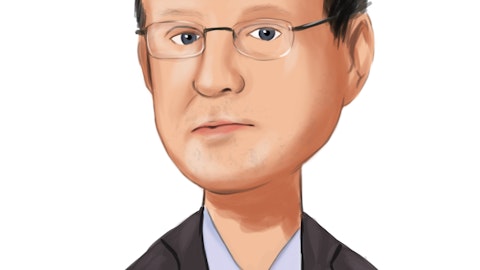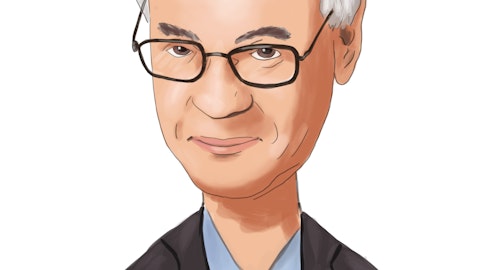WesBanco, Inc. (NASDAQ:WSBC) Q4 2022 Earnings Call Transcript January 25, 2023
Operator: Good day and welcome to the WesBanco, Inc. Fourth Quarter 2022 Earnings Conference Call. All participants will be in a listen-only mode. After today’s presentation, there will be an opportunity to ask questions. Please note, this event is being recorded. I would now like to turn the conference over to, John Iannone, Senior Vice President of Investor Relations. Please go ahead.
John Iannone: Thank you. Good morning. And welcome to WesBanco, Inc.’s fourth quarter 2022 earnings conference call. Leading the call today are Todd Clossin, President and Chief Executive Officer; Jeff Jackson, Senior Executive Vice President and Chief Operating Officer; and Dan Weiss, Executive Vice President and Chief Financial Officer. Today’s call, an archive of which will be available on our Web site for one year, contains forward-looking information. Cautionary statements about this information and reconciliations of non-GAAP measures are included in our earnings-related materials issued yesterday afternoon, as well as our other SEC filings and investor materials. These materials are available on the Investor Relations section of our Web site, wesbanco.com. All statements speak only as of January 25, 2023, and WesBanco undertakes no obligation to update them. I would now like to turn the call over to Todd. Todd?
Todd Clossin: Thank you, John. Good morning, everyone. On today’s call, we’ll review our results for the fourth quarter of 2022, and provide an update on our operations and current 2023 outlook. Key takeaways from the call today are our operational strategies and core advantages were evident throughout 2022, and were highlighted by our earning numerous national accolades. We had a solid financial performance demonstrated by loan growth, net interest margin expansion, and discretionary cost control. We remain well-positioned for continued success and are excited about our future growth opportunities. WesBanco had another successful year during 2022 as we remained focused on ensuring a strong organization for our shareholders, and continued to appropriately return capital to them through both long-term sustainable earnings growth and effective capital management.
Through successful operational execution we generated solid annual net income, while remaining a well-capitalized financial institution with strong liquidity, balance sheet, and credit quality metrics built upon our well-defined strategies and core advantages which will ensure success regardless of the economic environment. We are pleased with our performance during the fourth quarter of 2022 as we continued to deliver loan growth, controlled discretionary expenses, and maintained our reputation for credit quality. For the quarter ending December 31, 2022, we reported net income available to common shareholders of $49.7 million and diluted earnings per share of $0.84 when excluding after-tax merger and restructuring charges. On the same basis, for the full-year, we reported net income available to common shareholders of $183.3 million, and diluted earnings per share of $3.04.
Furthermore, the strength of our financial performance this past quarter is further demonstrated by a return on average assets of 1.18% and return on tangible equity of 16.05%. And our capital position remained strong and continues to provide financial and operational flexibility. Throughout the year, we accomplished several milestones and continued to receive numerous national accolades that resulted from our performance, operational strengths, and community focus. I’d be remiss if I do not congratulate our employees for these recognitions as they are a testament to their hard work and dedication. Just to highlight a few, WesBanco remains the leader in an advocate for its communities, and we continually look for ways to expand our outreach and involvement, including the issuance of our initial sustainability report.
We launched new loan production offices in Cleveland, Indianapolis, and Nashville, complementing our existing LPOs in and Northern Virginia. Based on customer satisfaction and consumer feedback, WesBanco Bank was named by Forbes as the number one bank in Ohio, and the number two bank in Kentucky, including high scores for trust, branched services, terms and conditions, customer service, digital services, and financial advice. For the fourth year in a row we were named one of the world’s best banks, which was also based on customer satisfaction and consumer feedback. For the third year in a row in the top 12, WesBanco Bank was once again named to the Forbes list of the best banks in America based upon growth, credit quality, and profitability.
We were named to the Forbes list of America’s Best Midsized Employers, earning a spot within the top 10 percent of all companies recognized, as well as securing the number two spot out of 30 companies included in the banking and financial services category. In fact, we were the only midsized bank making the top 10 for both financial performance and employer of choice. Finally, WesBanco was recognized as one America’s most trustworthy companies, as well as being one of only 20 banks to earn this nationwide honor for three touch points of trust; customer trust, investor trust, and employee trust. The key story this quarter was the strength of our lending teams as we demonstrated strong loan growth for the third consecutive quarter, combined with solid credit quality measures which continue to remain relatively low from a historical perspective, and consistent through at least the last 10-plus quarters.
Reflecting the strength of our markets and lending teams, we again reported solid broad-based loan growth during the quarter. Total loan growth, excluding SBA PPP loans, was 11.7% year-over-year and 4.2% or 16.8% annualized when compared to September 30, 2022. While key credit quality measures such as total loans past due and criticized and classified loans declined both year-over-year and sequentially to 0.19% and 2.34%, respectfully, of total loans. Despite mortgage originations of just $179 million during the fourth quarter, 90% of which were either purchase or construction, residential real estate loans increased more than 20% both year-over-year and sequentially annualized through the retention of approximately 80% of the 1-to-4 family residential mortgages generated by our team of mortgage loan originators.
Total commercial loan growth continues to benefit from our teams and markets that have been enhanced by our hiring efforts over the past two years. For the fourth quarter, total commercial loan growth was 9.6% year-over-year, and 4.1% from the third quarter or 16.2% annualized. Our commercial teams continue to find new business opportunities to replenish the pipeline. In addition to new loan originations of approximately $490 million during the fourth quarter, our commercial pipeline has remained relatively consistent since last quarter, at approximately $900 million. The strength of our pipeline represents the talent of our lending teams as well as early success from our loan production office strategy which only account for approximately 13% of the pipeline.
While we will see what the economy will provide this year, I am encouraged about our future commercial lending prospects as our newer lenders continue to gain traction, our recent LPOs gain market share, and we hire additional lenders. Through the last few years, we have transformed our company into an evolving regional financial services institution with a community bank at its core. We have done this through the successful expansion in a higher growth market spanning six states, with the majority of our company now located within these markets, while adhering to our foundation of disciplined, discretionary cost control, risk management, and credit standards. As we have discussed before, a key investment in support of this evolution has been and will continue to be the investment in our employees as they are critical to our long-term growth and success.
During both 2021 and 2022, we focused on improving retention and boosting morale by implementing increases in the hourly wage, which was very well-received. In addition, we developed plans to increase the depth and strength of our teams across our business lines and markets. We successfully executed upon these plans by hiring more than 45 revenue producers during 2021, and more than 50 during 2022, and have begun to see the growth and positive operating leverage from these investments. We will continue to enhance our evolution into a solid and sound growth story combined with our strong foundation and core advantages through an ongoing lender hiring strategy. While we will continue to evaluate existing lenders to ensure appropriate productivity, we plan to annually add high-value and productive individuals to enhance our ability to leverage growth opportunities across our markets.

Photo by Clay Banks on Unsplash
We remain focused on ensuring an organization with sound credit quality, solid liquidity, and a strong balance sheet. We have the right markets, teams, leadership, and strategies to provide long-term success for our shareholders, customers, and employees. We’re excited about our opportunities for the upcoming year. I would now like to turn the call over to Dan Weiss, our CFO, for an update on our fourth quarter financial results and current outlook for 2023. Dan?
Dan Weiss: Thanks, Todd, and good morning. During the quarter, we recognized strong loan growth, continued stability in our credit quality measures, improvement in our net interest margin, and maintained discipline over expenses. As noted in yesterday’s earnings release, during the fourth quarter, we reported improved GAAP net income available to common shareholders of $49.7 million, and earnings per diluted share of $0.84, and net income of $182 million, and earnings per share of $3.02 for the full-year. Excluding restructuring and merger-related charges, results for the three and 12 months, ending December 31, 2022, were $0.84 and $3.04 per share, respectively, as compared to $82 and $3.62 last year, respectively. It’s important to note that the 2021 was favorably impacted by a negative provision of $51.6 million net of tax or $0.79 per share, as compared to a benefit of $0.02 per share during 2022.
Total assets, of $16.9 billion as of December 31, 2022, included total portfolio loans of $10.7 billion and total securities of $3.8 billion. Loan balances for the fourth quarter of 2022, which grew both year-over-year and sequentially, reflected strong performance by our commercial and consumer lending teams and more 1-to-4 family residential mortgages retained on the balance sheet. Furthermore, as we expected, commercial real estate payoffs moderated this quarter, totaling approximately $63 million. We also reclassified $86 million of consumer loans secured by residential real estate to the HELOC category to better reflect the underlying collateral. SBA PPP in the prior-year period totaled approximately $163 million, as compared to $8 million this period.
Importantly, reflecting the strength of our underwriting standards, our key credit quality measures continue to remain at relatively low levels, and is favorable to peer averages. Robust deposit levels remain a key story as total deposits as of December 31st 2022 were $12.2 billion excluding CDs. Essentially flat compared to the prior year as growth in non-interest bearing demand deposits and savings accounts offset the decline in interest bearing demand deposit balances. Further, our non-interesting bearing deposits improved to 36% of total deposits. Total deposits at yearend were $13.1 billion, down 3.2% year-over-year due to a $407 million reduction in CDs. The net interest margin in the fourth quarter of 3.49% increased 16 basis points sequentially and 52 basis points year-over-year.
This increase reflects our successful deployment of excess cash into higher yielding loans combined with 425 basis point increase in the federal funds rate throughout the year. Our core margin continued to increase quarter-over-quarter from 3.27% to 3.44%, which excludes purchase accounting accretion of 5 basis points for both periods for SBA PPP loan accretion with a basis point or less for both periods. Our robust legacy deposit base provides a pricing advantage as compared to peers, especially those primarily in major metro markets. We are not immune to the impact of rising rates on our funding sources. Deposit funding cost for the fourth quarter of 2022 increased 44 basis points year-over-year to 57 basis points or 29 basis points when including non-interest bearing deposits.
This reflects a total deposit beta of 8% as compared to 375 basis point increase in the federal funds rate throughout the year, excluding December which did not meaningfully impact the year-to-date average. For the fourth quarter of 2022, non-interest income of $27.8 million was down $2.9 million year-over-year, primarily due to lower mortgage banking income which decreased $2.3 million due to reduction in residential mortgage originations consistent with the industry in general, and the retention of more loans on our balance sheet. Securities brokerage continued its organic growth trend as net revenues increased $1 million year-over-year to a record $2.6 million. Our commitment to discretionary expense control in an inflationary environment combined with loan growth and net interest margin expansion resulted in an improved efficiency ratio of 56.9%.
Excluding restructuring and merger-related expenses, non-interest expense for the three months ended December 31, 2022, totaled $90.4 million. A 2.6% increase year-over-year and a 1.6% decrease sequentially. It’s important to note that the fourth quarter included a couple of large credits totally approximately $2.5 million which are not expected to repeat in our expense run rate going forward. Within salaries and wages, there was a $1.8 million downward adjustment to bonus expense mostly related to lower mortgage lending commissions and annual volume based incentives. And with an employee benefits, there was a $600,000 credit related to the deferred compensation plan which fluctuates based on movement in underlying equity securities. Adding these two items back, non-interest expenses for the fourth quarter would have been approximately $93 million.
Turning to capital, during the fourth quarter the quarterly dividend was increased from $0.34 to $0.35 per share, representing a 2.9% increase. Our capital position remains solid is demonstrated by regulatory ratios that are above the applicable well-capitalized standards and our tangible common equity ratio improved to 7.28% as of December 31st 2022. Now I’ll provide some initial thoughts on our current outlook for 2023. We remain an asset-sensitive bank. And currently, model fed funds to peak at 5% during the first quarter. And then, hold steady throughout remaining quarters of 2023. We are modeling a couple basis points of margin expansion in the first quarter and hold relatively flat for the remainder of the year as deposit pricing continues to rise.
We expect purchase accounting accretion to be approximately four to five basis points per quarter and no meaningful SBA PPP accretion. As mentioned, a robust legacy deposit base provides pricing advantage for the industry. And we anticipate our deposit betas to continue to be lower than peers and to generally lag the industry. Residential mortgage originations should remain positive relative to industry trends due to our new loan production offices and hiring initiatives, as well as the anticipated stabilization in interest rates, and should begin to rebound as the year progresses. While it is dependent on origination production, we continue to expect to move, over time, to selling approximately 50% into the secondary market subject to customer preferences and pricing.
Trustees will continue to benefit slightly from organic growth, as well as be impacted by the trends in the equity and fixed income markets. As a reminder, first quarter trust fees are seasonally higher due to tax preparation. Securities brokerage revenue should continue to benefit modestly from year-over-year organic growth. Electronic banking fees and service charges on deposit will mostly likely remain in a similar range with the last few quarters as they are subject to overall consumer spending behaviors. In addition, we anticipate an increase in new commercial swap fee income above the approximate $4 million we’ve earned annually over the last few years as we have implemented improvements in our training and strategy. While we remain diligent on discretionary costs to help mitigate inflationary pressures, we intend to continue to make important growth-oriented investments in support of long-term sustainable revenue growth and shareholder return.
This will include ongoing efforts to attract and retain employees, in particular commercial lenders across our metro markets as we continue a similar hiring strategy that we implemented for 2022. We’ll continue to make improvements to infrastructure, which will include upgrading about a third of our ATM fleet with the latest technology, as well as other digital product enhancements. We anticipate higher pension expense of approximately $1 million per quarter within employee benefits based on an expected lower return on plan assets, and expect to be impacted by the industry-wide FDIC insurance rate increase. To support our growth plans across our markets, we anticipate investing more in marketing with a focus on revenue-generating campaigns.
We will also continue to evaluate our financial center network to identify cost-saving opportunities which could provide a benefit in the second-half of the year. Based on what we know today, we believe our quarterly expense run rate to be in the mid $90 million range. We believe that these investments are appropriate in support of long-term sustainable revenue growth and associated shareholder return, and will continue to drive positive operating leverage. The provision for credit losses in CECL will be dependent upon changes to the macroeconomic forecast and qualitative factors as well as various credit quality metrics, including potential charge-offs, criticized and classified loan balances, delinquencies, changes in prepayment speeds, and future loan growth.
Lastly, we currently anticipate our full-year effective tax rate to be between 19% and 20% subject to changes in tax legislation, deductions in credits, and taxable income levels. Operator, we are now ready to take questions. Would you please review the instructions?
See also 12 Best S&P 500 Dividend Stocks To Buy and 12 Cheap Biotech Stocks To Buy.
Q&A Session
Follow Wesbanco Inc (NASDAQ:WSBC)
Follow Wesbanco Inc (NASDAQ:WSBC)
Operator: We will now begin the question-and-answer session. The first question today comes from Daniel Tamayo with Raymond James. Please go ahead.
Daniel Tamayo: Good morning, guys.
Todd Clossin: Morning, Dan.
Daniel Tamayo: Maybe we start on the loan growth expectations, it’s — just interested in what you’re seeing and what you’re expecting for the coming year. And then with the loan deposit ratios still relatively low, how much are you willing to let that rise and fund from securities runoff?
Todd Clossin: Yes, okay, well, I’m glad to answer that, Dan. It’s — obviously, loan growth is going to be economy-dependent, right? So, a lot of mixed signals out there right now with regard to what the economy is going to do. I think we get the GDP number this Thursday, but I think in looking at kind of — our comments in the past have been upper single-digit growth on a long-term basis is kind of what we’ve been striving towards, and feel I guess where we were last year, yearly, in the upper single-digit low double-digit range. And that’s what we’re comfortable with, I think, on a longer term basis. Yes, pipelines continue to stay consistent, as I said in my comments as well too, so that looks good. And I think we’ve built the right organization in our growth markets to be able to finally achieve that path that we’ve been building for the last number of years on the upper single-digit growth rate.
So, I feel good about that, but I just don’t know what the economy is going to bring us right now. When I look at the deposit side of things, and Dan might want to jump in here as well too, and along the deposit ratio. It is an advantage that we have right now; we don’t want to give that all away, obviously. But we do expect to continue to have some solid loan growth over time, and the deposit base we’re going to need to build along with that. So, it wouldn’t be the plan to let that run too far, but at the same time we want to take advantage of that deposit funding advantage that we have. We’ll probably get into more deposit discussions in a little bit here, I would imagine. But when we really look at deposits, in general, obviously the CDs, we let those run off, we replaced those with some federal home loan bank borrowings.
But we are reintroducing some CD specials, nothing like you would see at some of our competitors in the higher growth markets. We think we can generate some CD business or at least slow the runoff of CDs in our legacy markets by just being a little more aggressive than we’ve been. But I would think that loan-to-deposit ratio may drift up a little bit more, but we really don’t want to give that all away. We’re comfortable in that 90% to 95% loan-to-deposit ratio over time. And when we were there a few years before the pandemic, I imagine we’ll get back to that point. So, how quickly we get there will be dependent upon how aggressive we need to be on deposits, and so really be driven by what kind of loan growth that we see. So, that’s a longwinded answer, but that’s kind of the best way I see it right now anyway.
Daniel Tamayo: No, that’s terrific, I appreciate all the color. And then maybe my follow-up just on credit quality, you’ve seen the reserve ratio come down here a decent amount over the last few quarters, settling around 110. Just curious what the big drivers are there? And then what would you need to see to have reserves grow from here, outside of an increase in loss content within the portfolio?



